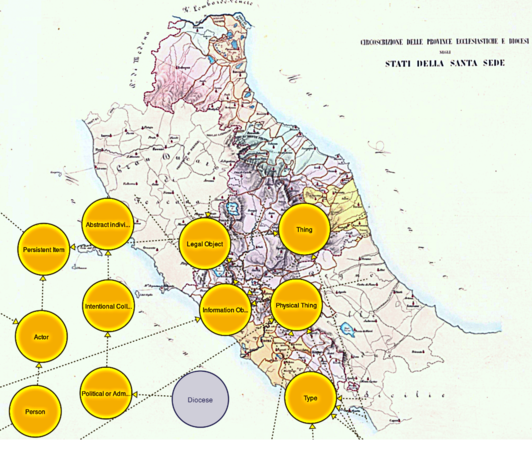Complex Geographies and Jurisdictions. Challenges of modelling and mapping the legal-historical evolution of Catholic dioceses
- Date: Apr 24, 2024
- Time: 09:30 AM - 01:00 PM (Local Time Germany)
- Location: mpilhlt, Turmcarree
- Host: Benedetta Albani (MPI), Rowan Dorin (Stanford University)
- Contact: albani@lhlt.mpg.de

The names of dioceses have long served as crucial identifiers in historical records, particularly within ecclesiastical documents. They were used for defining and distinguishing institutions, individuals, places, and actions, influencing how information is organized and understood. While the significance of diocesan affiliation may seem negligible in modern daily life, it holds paramount importance for scholars studying Christianity’s past and its interactions with various cultures and societies. Belonging to a specific diocese carried implications across legal, spiritual, cultural, geographical, and economic realms. The name of a diocese encapsulates, thus, its multifaceted nature, encompassing its geographical boundaries, relationship with the Apostolic See, hierarchical structure, religious practices, jurisdictional reach, and physical infrastructure. These aspects evolve over time, with diocesan histories marked by significant legal-historical changes such as establishment, merger, suppression, relocation of episcopal seats, and alterations in relationships with higher authorities.
Understanding the significance of a diocese’s name requires contextualizing it within its historical milieu. The vast literature on diocesan history varies in scope, ranging from localized studies focusing on individual dioceses or regions to comprehensive examinations covering all Catholic or Eastern Christian dioceses. Institutions continually update and publish information on dioceses and their bishops, often accessible online for various purposes including academic research, public dissemination, and administrative use. However, online data on dioceses pose several challenges. Variations in data collection methods result in discrepancies in accuracy and detail, while inadequate referencing and standardization hinder comparability and clarity. Descriptions of diocesan evolution typically lack formal standardization and systematic documentation, limiting the ability to track legal-historical changes and identify distinct phases of diocesan development with precision.
This meeting arose from the cooperation between the Research Group Normative Knowledge in the praxis of the Congregation of the Council active at the Max Planck Institute for Legal History and the project Digital Atlas of Dioceses and Ecclesiastical Provinces in Late Medieval Europe (1200-1500) at Stanford University, which together collaborate on the Orbis Dioecesium (OrDi)project. The aim of the meeting is to discuss together with other researchers and research groups facing similar challenges in modelling and mapping the legal-historical evolution of Catholic dioceses. Particular emphasis will be placed on comparing data models and ontologies tested in the various research projects participating in the meeting, exploring different strategies for mapping historical areas, and reflecting on the transposition of historical data into a digital environment, all with a view to working together to foster the interoperability of data between various projects and their accessibility.
Given the specific nature of the topics and discussion, the meeting is open to researchers and research groups actively involved in data modelling in the specific legal-historical context outlined above. For more information, and to propose your participation (in-presence or online), please write to Benedetta Albani albani@lhlt.mpg.de.